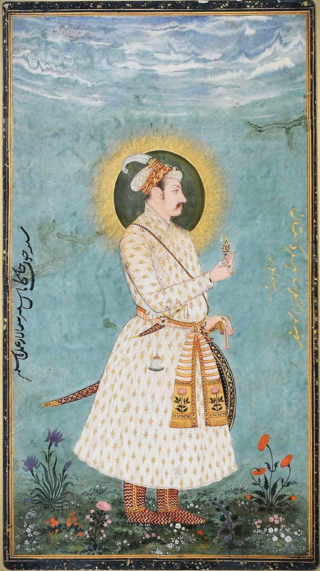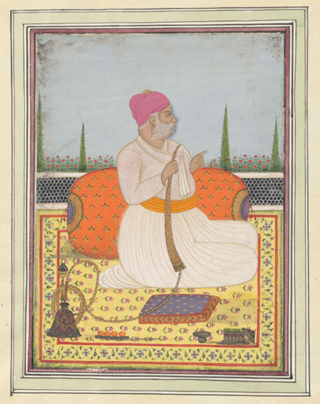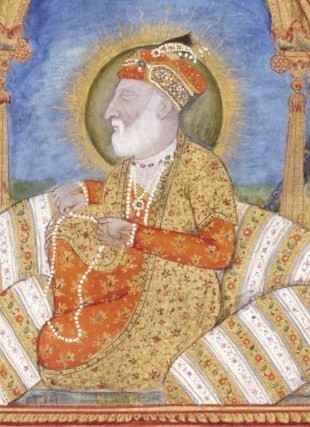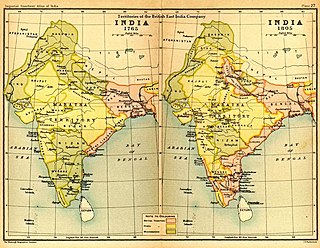
Bajirao I, born as Visaji, was the 7th Peshwa of the Maratha Confederacy. During his 20-year tenure as a Peshwa, he made several military campaigns against the Mughal Empire, Nizam of Hyderabad, Siddis of Janjira and the Rajput Kingdoms. Battles with Nizam were highlights of his career and turning points for the Maratha empire, most notable out of them are Battle of Palkhed and Battle of Bhopal. BajiRao made efforts to establish Maratha dominance in the subcontinent against Mughals and in 1737, Bajirao raided Delhi, the capital of the Mughal empire.

The Maratha Empire, also referred to as the Maratha Confederacy, was an early modern Indian empire and later a confederation that controlled large portions of the Indian subcontinent in the 18th century. Maratha rule formally began in 1674 with the coronation of Shivaji of the Bhonsle dynasty as the Chhatrapati. Although Shivaji came from the Maratha caste, the Maratha empire also included warriors, administrators, and other nobles from the Maratha and several other castes from what is known today as Maharashtra.

Awadh, known in British historical texts as Avadh or Oudh, is a historical region in northern India, now constituting the northeastern portion of Uttar Pradesh. It is roughly synonymous with the ancient Kosala region of Hindu, Buddhist, and Jain scriptures.

The United Provinces of Agra and Oudh was a province of India under the British Raj, which existed from 1902 to 1937; the official name was shortened by the Government of India Act 1935 to United Provinces (UP), by which the province had been commonly known, and by which name it was also a province of independent India until 1950.

Mirza Nasir-ud-Din Muḥammad Shah was the thirteenth Mughal emperor from 1719 to 1748. He was son of Khujista Akhtar, the fourth son of Bahadur Shah I. After being chosen by the Sayyid Brothers of Barha, he ascended the throne at the young age of 16, under their strict supervision.

Balaji Baji Rao, often referred to as Nana Saheb I, was the 8th Peshwa of the Maratha Confederacy. He was appointed as Peshwa in 1740 upon the death of his father, the Peshwa Bajirao I.

Suraj Mal was a Jat ruler of Bharatpur in present-day state of Rajasthan. Under him, the Jat rule covered the present-day districts of Agra, Aligarh, Bharatpur, Dholpur, Etawa, Hathras, Mainpuri, Mathura, and Rohtak.

Rohillas are a mixed Indian community of Pashtun heritage, historically found in Rohilkhand, a region in the state of Uttar Pradesh, India. It forms the largest Pashtun diaspora community in India, and has given its name to the Rohilkhand region. The Rohilla military chiefs settled in this region of northern India in the 1720s, the first of whom was Ali Mohammed Khan.

Ahmad Shah Bahadur, also known as Mirza Ahmad Shah or Mujahid-ud-Din Ahmad Shah Ghazi, was the fourteenth Mughal emperor, born to Emperor Muhammad Shah. He succeeded his father to the throne in 1748, at the age of 22. When Ahmed Shah Bahadur came to power, the Mughal Empire started to decline. Furthermore, his administrative weakness eventually led to the rise of the usurping Imad-ul-Mulk.

Shah Alam II, also known by his birth name Ali Gohar, or Ali Gauhar, was the seventeenth Mughal emperor and the son of Alamgir II. Shah Alam II became the emperor of a crumbling Mughal Empire. His power was so depleted during his reign that it led to a saying in the Persian language, Sultanat-e-Shah Alam, Az Dilli ta Palam, meaning, 'The empire of Shah Alam is from Delhi to Palam', Palam being a suburb of Delhi.

Raghunathrao Bhat, also known as Ragho Ballal or Ragho Bharari, was the 11th Peshwa of the Maratha Empire for a brief period from 1773 to 1774. He was known among the Hindus for his extremely successful Delhi and North-western campaign in 1757-59 and for his works to liberate the Hindu holy places of Kashi and Ayodhya.

Malhar Rao Holkar was a noble subedar of the Maratha Empire, in present-day India. He was one of the early officers along with Ranoji Scindia to help spread the Maratha rule to northern states and was given the estate of Indore to rule by the Peshwas, during the reign of the Maratha emperor Shahu I. He was founder of the Holkar dynasty that ruled Malwa.

Najib ad-Dawlah, also known as Najib Khan Yousafzai, was a Rohilla Yousafzai Afghan who earlier served as a Mughal serviceman but later deserted the cause of the Mughals and joined Ahmed Shah Abdali in 1757 in his attack on Delhi. He was also a House chief of Rohilkhand, and in the 1740s founded the city of Najibabad in Bijnor district, India. He was instrumental in winning the Third Battle of Panipat.

The Maratha Conquests were a series of conquests in the Indian subcontinent which led to the building of the Maratha Empire. These conquests were started by Shivaji in 1659, from the victory at the Battle of Pratapgad against Bijapur. The expansion of the empire was limited and interrupted by the Mughal conquests of south India by Mughal emperor Aurangzeb. Marathas were forced to defend their territories against the overwhelmingly strong Mughal army in the 27 years long Deccan wars. They were able to defend their territories and gain an upper hand over Mughals in the sustained conflict.

Prayagraj, also known as Ilahabad or Allahabad in an anglicized version in Roman script, and anciently Prayag, is a city situated on an inland peninsula, surrounded by the rivers Ganges and Yamuna on three sides, with only one side connected to the mainland Doab region, of which it is a part. This position is of importance in Hindu scriptures for it is situated at the confluence, known as Triveni Sangam, of the holy rivers. As per Rigveda the Sarasvati River was part of the three river confluence in ancient times. It is one of four sites of the Kumbh Mela, an important mass Hindu pilgrimage.

The Nawab of Awadh or the Nawab of Oudh was the title of the rulers who governed the state of Awadh in north India during the 18th and 19th centuries. The Nawabs of Awadh belonged to an Iranian dynasty of Sayyid origin from Nishapur, Iran. In 1724, Nawab Sa'adat Khan established the Oudh State with their capital in Faizabad and Lucknow.

The Maratha raid on Delhi was a raid which took place on 28 March 1737 by the Marathas against the Mughal Empire at Talkatora near Delhi. Bajirao marched towards Delhi to avenge the defeat of Marathas at the Battle of Jalesar by Saadat Ali Khan. The Marathas under Bajirao raided Delhi after defeating the Mughal army under Hasan Khan Kota. Hearing the approach of the Vizier Qamar-ud-Din Khan, the Maratha forces retreated from Delhi but were defeated by the Vizier's forces near Badshahpur, 20 miles away from Delhi.

Nawab Ghazanfar-Jang, Bangash Khan was the first Nawab of Farrukhabad in Uttar Pradesh, India. He was a "Bawan Hazari Sardar" in the Mughal Army. He served as governor of Malwa and Allahabad provinces of the Mughal empire. He was also viceroy of Assam from 1735 to 1743. Although regarded as rude and illiterate, not understanding a single word of Persian or Pashto, he was well regarded for his loyalty, and it is believed that had fortune sided with him he would have been able to establish a kingdom rivalling those in the Deccan or Awadh.

The Oudh State was a princely state in the Awadh region of North India until its annexation by the British in 1856. The name Oudh, now obsolete, was once the anglicized name of the state, also written historically as Oudhe.
Maharaja Beni Bahadur was an administrator, minister, soldier and househelp in the courts of the Nawabs of Awadh from 1733 / 1734 to at least 1798 and at most 1814. He was most notable for his rapid rise to power, industry and charity.



















